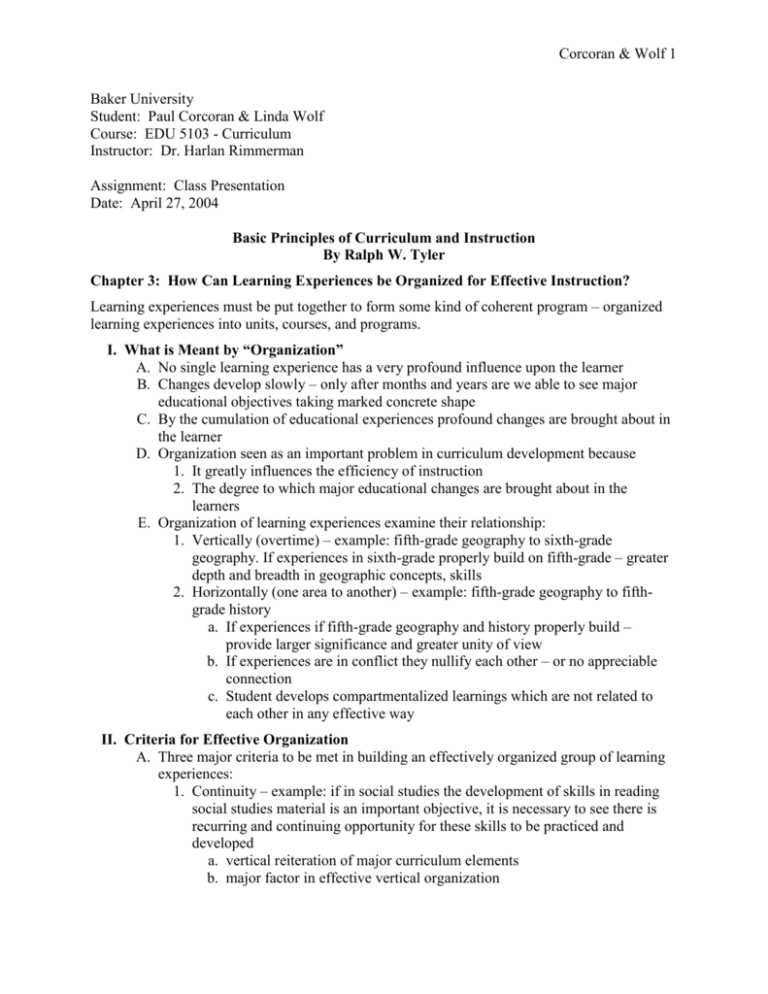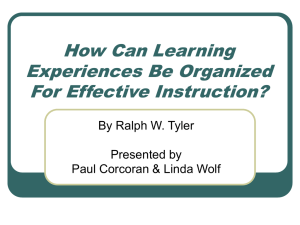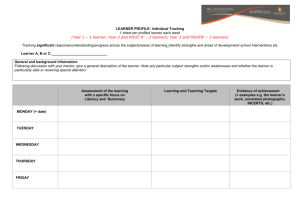Basic Principles of Curriculum and Instruction
advertisement

Corcoran & Wolf 1 Baker University Student: Paul Corcoran & Linda Wolf Course: EDU 5103 - Curriculum Instructor: Dr. Harlan Rimmerman Assignment: Class Presentation Date: April 27, 2004 Basic Principles of Curriculum and Instruction By Ralph W. Tyler Chapter 3: How Can Learning Experiences be Organized for Effective Instruction? Learning experiences must be put together to form some kind of coherent program – organized learning experiences into units, courses, and programs. I. What is Meant by “Organization” A. No single learning experience has a very profound influence upon the learner B. Changes develop slowly – only after months and years are we able to see major educational objectives taking marked concrete shape C. By the cumulation of educational experiences profound changes are brought about in the learner D. Organization seen as an important problem in curriculum development because 1. It greatly influences the efficiency of instruction 2. The degree to which major educational changes are brought about in the learners E. Organization of learning experiences examine their relationship: 1. Vertically (overtime) – example: fifth-grade geography to sixth-grade geography. If experiences in sixth-grade properly build on fifth-grade – greater depth and breadth in geographic concepts, skills 2. Horizontally (one area to another) – example: fifth-grade geography to fifthgrade history a. If experiences if fifth-grade geography and history properly build – provide larger significance and greater unity of view b. If experiences are in conflict they nullify each other – or no appreciable connection c. Student develops compartmentalized learnings which are not related to each other in any effective way II. Criteria for Effective Organization A. Three major criteria to be met in building an effectively organized group of learning experiences: 1. Continuity – example: if in social studies the development of skills in reading social studies material is an important objective, it is necessary to see there is recurring and continuing opportunity for these skills to be practiced and developed a. vertical reiteration of major curriculum elements b. major factor in effective vertical organization Corcoran & Wolf 2 2. Sequence – example: in the development of reading skills is social studies would involve the provision for increasingly more complex social studies material a. related to continuity but goes beyond. Possible for major curriculum to recur but merely at same level – no progressive development of understanding, skill, attitude, etc b. emphasizes importance of having each successive experience build upon the preceding one but go more broadly and deeply into the matters involved. c. emphasizes no duplication - rather higher levels of treatment with each successive learning experience 3. Integration – example: in developing concepts in social studies it is important to see how these ideas can be related to work going on in other subject fields so that increasingly there is unity in the student’s outlooks, skill, attitudes a. the horizontal relationship of curriculum experiences b. help the student increasingly to get a unified view and to unify their behavior in relation to the elements dealt with B. Continuity, sequence, integration – basic guiding criteria in building an effective scheme of organization of learning experiences III. Elements to Be Organized A. In working out a plan of organization for a curriculum, it is necessary to identify the elements of that curriculum which serve as a thread - example: in mathematics “place value” in number system represents a very basic idea in understanding our methods of addition, subtraction, multiplication, and division. This concept is understood at a relatively low level by the fourth-grade child but can be developed into a much broader and deeper concept by the end of the ninth-grade. B. This would be one element that could serve as an organizing element in achieving continuity and sequence C. This element might also be a useful element in developing integration since the concept of the place value of a number system might be carried over to appropriate application in shop, in social studies, in science, and other fields D. In planning the curriculum for any school it is necessary to decide on the types of elements which most effectively serve as threads to use in the organization E. The Social Studies Curriculum Committee of Dalton Schools in New York City. The Committee identified three kinds of common elements: concepts, values, and skills – the widely-used concept of interdependence of peoples runs throughout. Tentative List of Common Elements in the Social Studies Curriculum Page: 89-94 F. In working on the curriculum in any field, it will be necessary to identify elements that are relevant to and significant matters for that field as well as for the total curriculum IV. Organizing Principles A. Not only necessary to recognize that learning experiences need to be organized to achieve continuity, sequence, and integration, and that major elements must be identified to serve as organizing threads for these learning experiences, it is also Corcoran & Wolf 3 B. C. D. E. essential to identify the organizing principles by which these threads shall be woven together. Example: concept of interdependence of all people 1. Primary grades begin with recognition on the part of the learner that he is dependent upon his parents, upon others, and milkman, and upon others, and they in turn are dependent upon him in certain limited respects 2. Broaden and deepened by increasing the range of persons which the student recognizes as being interdependent with him (people in other cities, states, and nations 3. Recognize interdependence in economic matters, in social matters Organizing principles are needed that can serve as a basis for planning the respects in which the broadening and the deepening of major curriculum elements in the program will take place It is necessary to note that the criteria, continuity, sequence, and integration apply to the experiences of the learner 1. Continuity involves the recurring emphasis in the learner’s experience upon these particular elements 2. Sequence refers to the increasing breadth and depth of the learner’s development 3. Integration refers to the learner’s increased unity of behavior in relating to the elements involved Organizing principles need to be considered in terms of their psychological significance to the learner 1. Logical organization a relationship which has meaning and significance to an expert in the field 2. Psychological organization can be a scheme of development in relations meaningful to the learner 3. Chronological organization is letting the student sees the development of events over time 4. Other organizing principles commonly used include: a. Increasing breadth of application b. Increasing range of activities included c. Use of description followed by analysis d. Development of specific illustrations followed by broader and broader principles to explain these illustrations e. Attempt to build and increasingly unified world picture from specific parts which are first built into larger and larger wholes It is important that working upon any particular curriculum possible principles of organization are examined and decisions made tentatively to be checked by actual tryout of the material to see how far these principles prove satisfactory in developing continuity, sequence, and integration V. The Organizing Structure A. It is necessary to consider the main structural elements in which the learning experiences are to be organized 1. Largest level of structural elements a. specific subjects – geography, arithmetic, history, spelling, handwriting Corcoran & Wolf 4 b. broad fields – social studies, mathematics, language arts, natural sciences c. a core curriculum for general education combined with broad fields or with specific subjects d. a completely undifferentiated structure in which the total program is treated as a unit 2. Intermediate level of structural elements a. courses organized as sequences – social science I, social science II, and social science III – definitely planned as a unifying sequence b. courses that are single semester or year units without being planned or considered as part of a longer time sequence 3. Lowest level of structural elements a. the lesson – single day treated as discrete unit and lesson plans for that day were more or less separate from other lessons of the day b. the topic – may last for several days or several weeks c. the unit – usually includes experiences covering several weeks and is organized around problems or major student purposes B. From the standpoint of the achievement of continuity and sequence the discrete subjects, the discrete courses for each semester or year, and discrete lessons all impose difficulties that make vertical organization less likely to occur C. Vertical organization is facilitated when the courses are organized over a period of years in larger units and in a larger general framework D. From the standpoint of achieving desirable organization, any structural arrangement that provides for larger blocks of time under which planning may go on has an advantage over a structural organization which cuts up the total time into many specific units, each of which has to be planned with some kind of transition and consideration of the work of other units. VI. The Process of Planning a Unit of Organization A. The ways of attaching the development of organization involve the following steps: 1. Agreeing upon a general scheme of organization – whether specific subjects, broad fields, or core programs are to be used 2. Agreeing upon the general organizing principles to be followed within each of the fields decided on 3. Agreeing upon the kind of low level unit to be used – daily lessons, or sequential topics, or teaching units 4. Developing flexible plans or so called “source units” which will be in the hands of each teacher as they work with a particular group A typical “source unit” includes: a. a statement of major objectives expected to be obtained from the kinds of learning experiences out-lined b. a description of a variety of experiences that can be used in attaining these objectives c. an outline in some detail of the culminating experiences that can be used to help the student at the end to integrate and organize what they got from the unit d. a list of source materials that will help in the development of the unit – including books and other references, slides, radio programs, pictures, etc Corcoran & Wolf 5 e. an indication of the expected level of development of the major elements that operate as the organizing elements in the curriculum f. necessary to prevent duplication on the one hand and avoid undue omissions or big jumps in student development on the other hand 5. Using pupil-teacher planning for the particular activities carried on by a particular class. B. It can be seen that planning the organization of curriculum experiences involves both a great deal of pre-planning and also planning as the work goes on, but it is only in this way that it is possible to get the greatest cumulative effect from the various learning experiences used. Websites for further research: http://www.umanitoba.ca/centres/ukrainian_canadian/hlynka/courses/132756/lecture2.html http://www.blackwell-synergy.com/openurl?genre=article&sid=vendor:database&issn=01614681&volume=105&issue=5&spage=699 http://www.successforall.net/resource/research/modeleffect.htm http://www.coe.ufl.edu/Courses/TODD/GailRing/curriculum.html http://www.infed.org/biblio/b-curric.htm http://www.mnstate.edu/suomala/632/632%20syllabus%201_00.htm http://library.fgcu.edu/Conferences/infostrategies00/presentations/Design%20Principles.htm http://www.ericfacility.net/ericdigests/ed369034.html http://www.owlnet.rice.edu/~educ420/04syll.html http://enhancinged.wgbh.org/research/additional.html http://ncsall.gse.harvard.edu/fob/2003/prevedel.html http://gseweb.harvard.edu/~ncsall/fob/2003/fob_6c.pdf http://scholar.lib.vt.edu/ejournals/JTS/Winter-Spring-2001/pdf/sutliff.pdf http://teacher.depaul.edu/ResearchBase/Learning_and_Assessment.pdf http://www.cmu.edu/blackboard/help/bbincdocs/BBInstructional_Design_Tips.doc http://www.dur.ac.uk/its/lt/duo/duopdfs/Instructional_Design_Tips.pdf Corcoran & Wolf 6 http://www.edci.purdue.edu/aged/coursepackets/pac319-04.pdf http://www.emich.edu/public/loex/Proceedings03/Krueger.doc http://www.ieq.org/pdf/EducQualFramework.pdf http://www.personal.kent.edu/~jhenders/syllabi/C&%20I%2087001.doc http://cyberlearn.fau.edu/kizlik/janus/miguez.htm http://www.pct.edu/disteduc/what_is_distance_learning.htm http://www.lehrplan.ch/symposium/hyun.htm http://www.sasked.gov.sk.ca/docs/physed/physed1-5/ep_planning.html http://www.ittheory.com/tyler.htm http://www.ncrel.org/sdrs/areas/issues/educatrs/profdevl/pd200.htm








